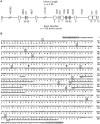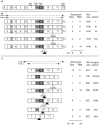Mis-spliced transcripts of nicotinic acetylcholine receptor alpha6 are associated with field evolved spinosad resistance in Plutella xylostella (L.)
- PMID: 20062520
- PMCID: PMC2792709
- DOI: 10.1371/journal.pgen.1000802
Mis-spliced transcripts of nicotinic acetylcholine receptor alpha6 are associated with field evolved spinosad resistance in Plutella xylostella (L.)
Abstract
The evolution of insecticide resistance is a global constraint to agricultural production. Spinosad is a new, low-environmental-risk insecticide that primarily targets nicotinic acetylcholine receptors (nAChR) and is effective against a wide range of pest species. However, after only a few years of application, field evolved resistance emerged in the diamondback moth, Plutella xylostella, an important pest of brassica crops worldwide. Spinosad resistance in a Hawaiian population results from a single incompletely recessive and autosomal gene, and here we use AFLP linkage mapping to identify the chromosome controlling resistance in a backcross family. Recombinational mapping with more than 700 backcross progeny positioned a putative spinosad target, nAChR alpha 6 (Pxalpha6), at the resistance locus, PxSpinR. A mutation within the ninth intron splice junction of Pxalpha6 results in mis-splicing of transcripts, which produce a predicted protein truncated between the third and fourth transmembrane domains. Additional resistance-associated Pxalpha6 transcripts that excluded the mutation containing exon were detected, and these were also predicted to produce truncated proteins. Identification of the locus of resistance in this important crop pest will facilitate field monitoring of the spread of resistance and offer insights into the genetic basis of spinosad resistance in other species.
Conflict of interest statement
The authors have declared that no competing interests exist.
Figures





Similar articles
-
A three amino acid deletion in the transmembrane domain of the nicotinic acetylcholine receptor α6 subunit confers high-level resistance to spinosad in Plutella xylostella.Insect Biochem Mol Biol. 2016 Apr;71:29-36. doi: 10.1016/j.ibmb.2016.02.001. Epub 2016 Feb 6. Insect Biochem Mol Biol. 2016. PMID: 26855198 Free PMC article.
-
Transcripts of the nicotinic acetylcholine receptor subunit gene Pxylα6 with premature stop codons are associated with spinosad resistance in diamondback moth, Plutella xylostella.Invert Neurosci. 2010 Nov;10(1):25-33. doi: 10.1007/s10158-010-0102-1. Epub 2010 May 25. Invert Neurosci. 2010. PMID: 20499126
-
Truncated transcripts of nicotinic acetylcholine subunit gene Bdα6 are associated with spinosad resistance in Bactrocera dorsalis.Insect Biochem Mol Biol. 2012 Oct;42(10):806-15. doi: 10.1016/j.ibmb.2012.07.010. Epub 2012 Aug 5. Insect Biochem Mol Biol. 2012. PMID: 22898623
-
Rapid selection for resistance to diamide insecticides in Plutella xylostella via specific amino acid polymorphisms in the ryanodine receptor.Neurotoxicology. 2017 May;60:224-233. doi: 10.1016/j.neuro.2016.05.012. Epub 2016 May 28. Neurotoxicology. 2017. PMID: 27246647 Free PMC article. Review.
-
The emerging importance of noncoding RNAs in the insecticide tolerance, with special emphasis on Plutella xylostella (Lepidoptera: Plutellidae).Wiley Interdiscip Rev RNA. 2019 Sep;10(5):e1539. doi: 10.1002/wrna.1539. Epub 2019 May 2. Wiley Interdiscip Rev RNA. 2019. PMID: 31045325 Review.
Cited by
-
An update of KAIKObase, the silkworm genome database.Database (Oxford). 2021 Feb 27;2021:baaa099. doi: 10.1093/database/baaa099. Database (Oxford). 2021. PMID: 33645624 Free PMC article.
-
Expression of subunits of an insecticide target receptor varies across tissues, life stages, castes, and species of social bees.Mol Ecol. 2023 Mar;32(5):1034-1044. doi: 10.1111/mec.16811. Epub 2023 Jan 17. Mol Ecol. 2023. PMID: 36478483 Free PMC article.
-
Nicotinic acetylcholine receptor modulator insecticides act on diverse receptor subtypes with distinct subunit compositions.PLoS Genet. 2022 Jan 19;18(1):e1009920. doi: 10.1371/journal.pgen.1009920. eCollection 2022 Jan. PLoS Genet. 2022. PMID: 35045067 Free PMC article.
-
Development of Near-Isogenic Lines in a Parthenogenetically Reproduced Thrips Species, Frankliniella occidentalis.Front Physiol. 2017 Mar 13;8:130. doi: 10.3389/fphys.2017.00130. eCollection 2017. Front Physiol. 2017. PMID: 28348528 Free PMC article.
-
Retroelement co-option disrupts the cancer transcriptional programme.Genome Med. 2025 May 7;17(1):48. doi: 10.1186/s13073-025-01479-9. Genome Med. 2025. PMID: 40336011 Free PMC article.
References
-
- Talekar NS, Shelton AM. Biology, ecology and management of the diamondback moth. Annu Rev Entomol. 1993;38:275–301. - PubMed
-
- Sawicki RM. Definition, detection and documentation of insecticide resistance. In: Ford MG, Holloman DW, Khambay BPS, Sawicki RM, editors. Combating Resistance to Xenobiotics: Biological and Chemical Approaches. Chichester, UK.: Ellis Horwood; 1987. pp. 105–117.
-
- Shelton AM, Wyman JA, Cushing NL, Apfelbeck K, Dennehy TJ, et al. Insecticide resistance of diamondback moth (Lepidoptera: Plutellidae) in North America. Journal of Economic Entomology. 1993;86:11–19.
-
- Tabashnik BE, Cushing NL, Finson N, Johson MW. Field development of resistance to Bacillus thuringiensis in Diamondback moth (Lepidoptera: Plutellidae). J Econ Entomol. 1990;83:1671–1676.
-
- Zhao JZ, Li YX, Collins HL, Gusukuma-Minuto L, Mau RFL, et al. Monitoring and characterization of diamondback moth (Lepidoptera: Plutellidae) resistance to spinosad. Journal of Economic Entomology. 2002;95:430–436. - PubMed
Publication types
MeSH terms
Substances
Grants and funding
LinkOut - more resources
Full Text Sources
Other Literature Sources

